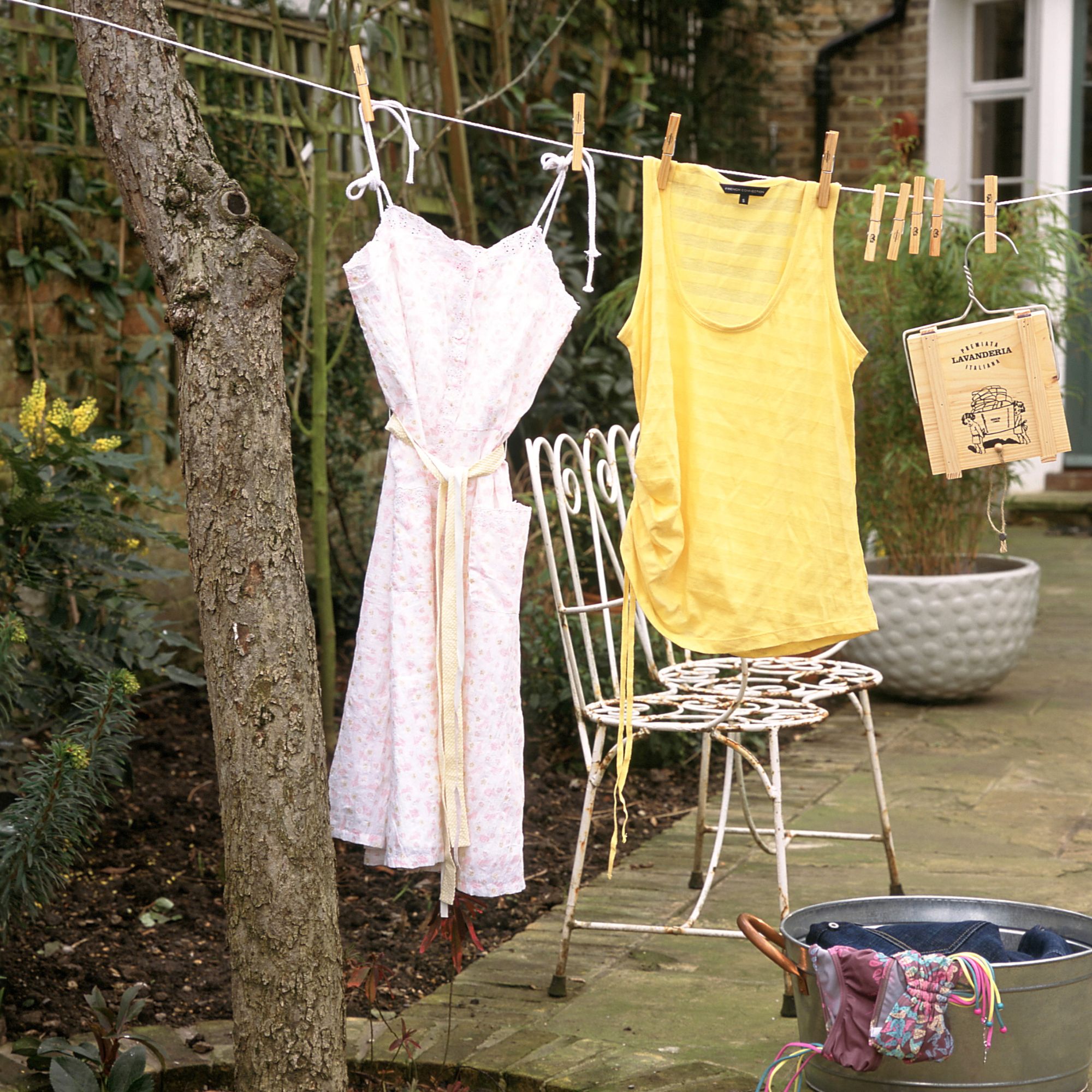
Is there anything more satisfying than seeing a load of washing drying on the washing line? Didn’t think so. And if you’re anything like me, you probably want to whip the washing line out as soon as the sun starts to peek through the clouds. But it turns out that there are some things you should never dry on a washing line.
Yep, although the best heated clothes airers are my saving grace during the colder and wetter months of the year, there’s nothing quite like drying laundry items outside. Everything dries so much faster, it smells better, and it doesn’t take up so much space in the house. And while I’ve tended to opt for the ‘shove everything on the washing line without thinking about it’ method, recent conversations with laundry experts on drying clothes quickly have me doubting everything.
As Deyan Dimitrov, CEO of Laundryheap, told me, ‘Drying clothes on the washing line is common. But think before you peg. Certain garments don’t pair well with the outdoor elements.’ So, these are the 4 things you should never dry on a washing line, and what you can do instead.
1. Towels
I’m definitely guilty of not washing my towels as often as I should (I know, I know, I should know better), but I’m also guilty of hanging them on the washing line when I do get around to washing them. And according to Deya, this is one of the worst things you can do with the best bath towels.
He says, ‘Wind speeds up the drying process, but the wind is a harsh opponent. It can leave garments feeling rough, scratchy and less soft. For these items, it’s best to stick to a tumble dryer.’

Not only that, but Lisa Talbot, an award-winning personal stylist, also says that drying towels on the washing line can also affect their longevity. She warns, ‘While they may seem hardy, sunlight can stiffen towels and reduce their absorbency. They may also become scratchy, especially if air-dried outdoors on windy days.’
Of course, if you don’t have a tumble dryer, drying them inside is another alternative. And if you want to ensure that they stay extra soft and fluffy, it’s well worth washing your towels with vinegar, too. This Miniml White Vinegar from Lakeland is always my go-to.
2. Dark coloured clothes
Although you can hang a load of white washing on the line without any concerns, you need to be a little more careful when it comes to dark coloured clothes or items. In fact, Deyan warns, ‘Strong UV rays can cause more damage to your clothes than you might expect. UV light can break down clothing fibres, and also encourages colour fade by degrading the dyes in fabrics.’
And while UV rays are stronger on a sunnier day, they can still be damaging on a cloudy day - and more susceptible to harm your darker coloured clothes than your lighter ones. So, it’s a good idea to protect them as much as possible, just like how you should protect conservatory furniture from the sun, too.

However, the experts at Banana Moon Clothing state that you don’t have to stop putting dark clothing on a washing line completely. You just need to modify your methods to ensure they’re not spending too much time in direct sunlight.
They say, ‘Instead, try drying your clothing in direct sunlight for a smaller period of time, maybe an hour or so, then move the clothing into a more shaded area. The warmer air and spring breeze will be enough to dry your garments without too much exposure to the sun.’
Alongside shielding your clothes from harmful UV rays and strong sunlight, the cover on this genius washing line can also shield them from light showers and bird poo!
3. Textured fabrics
Sometimes, the reason you shouldn’t dry laundry items on a washing line isn’t because of how the outside will affect the item, but rather how the item will affect you. This is especially true if you suffer from allergies or hay fever and want to pollen-proof your home.
As Deyan explains, ‘Another outdoor enemy is pollen. Pollen loves to stick to absorbent fabrics like cotton, and can get trapped in the tiny surface pockets of textured fabrics like corduroy and terry cloth.’

But what can you do? Well, ‘If you suffer from hayfever, avoid drying your favourite cotton shirts, corduroy skirts or towels on the washing line during peak pollen seasons,’ advises Deyan. If this isn’t possible, you should at least avoid hanging these textured materials out to dry when the pollen count is at its highest.
This is typically in the early morning and late afternoon/early evening. So, pop it out to dry during the middle of the day when the pollen count is typically lower instead. And for extra peace of mind, you could always use a lint roller like this Korbond Lint Roller from Amazon on your clothes before you store them.
4. Anything made from silk, satin or lace
If you’ve just bought a new pillowcase and want to know how to wash a silk pillowcase, or your fancy satin dress needs a whip around in the washing machine, it’s important to note that delicate fabrics like silk, satin or lace are also some of the laundry items you shouldn’t dry on a washing line.
Lisa warns, ‘These materials are vulnerable to direct sunlight, which can cause fading, weakening of fibres, and yellowing, especially with light coloured pieces. Delicate stitching can also warp in a breeze.’

Because of this, she suggests air drying these delicate fabrics inside and away from any heat, sunlight, or wind. In fact, she says the best way to dry these items is to ‘air dry these indoors on a hanger or flat surface away from direct heat.’
If you can, opt for flocked hangers rather than plastic or metal, as this will also help you maintain the integrity of these delicate materials and ensure they stay in your wardrobe for years to come. Just make sure you know what to do with old hangers if you’re swapping them out.
If you need to stock up on some flocked hangers to dry your delicates, you can pick up a pack of 25 for a very affordable price. And if you don't like the grey, you can buy them in a cream colourway instead.
FAQs
Can you dry a duvet on a washing line?
Yes, you can! Drying a duvet on a washing line is a great way to quickly and efficiently remove any excess moisture. However, it’s important to ensure that it dries fully before taking it outside, which is why most experts would suggest laying it out as flat as possible instead of allowing it to bunch up on the washing line.
Is it true that if the ground is dry your washing will dry?
Yes, this is generally true. If the ground is dry, this means there’s very little moisture in the air to prevent your washing from drying outside. This low humidity, coupled with a rainless day and potentially even some sunshine, are the perfect conditions to pop your laundry out on a washing line.
If the ground is wet, this is a clear sign that there’s moisture in the air or within the nearby surroundings. This can result in your washing taking longer than usual to dry.
So, there you have it! Hopefully now you'll think before you peg.







